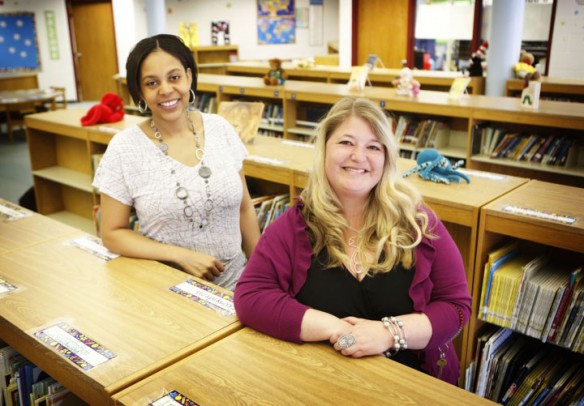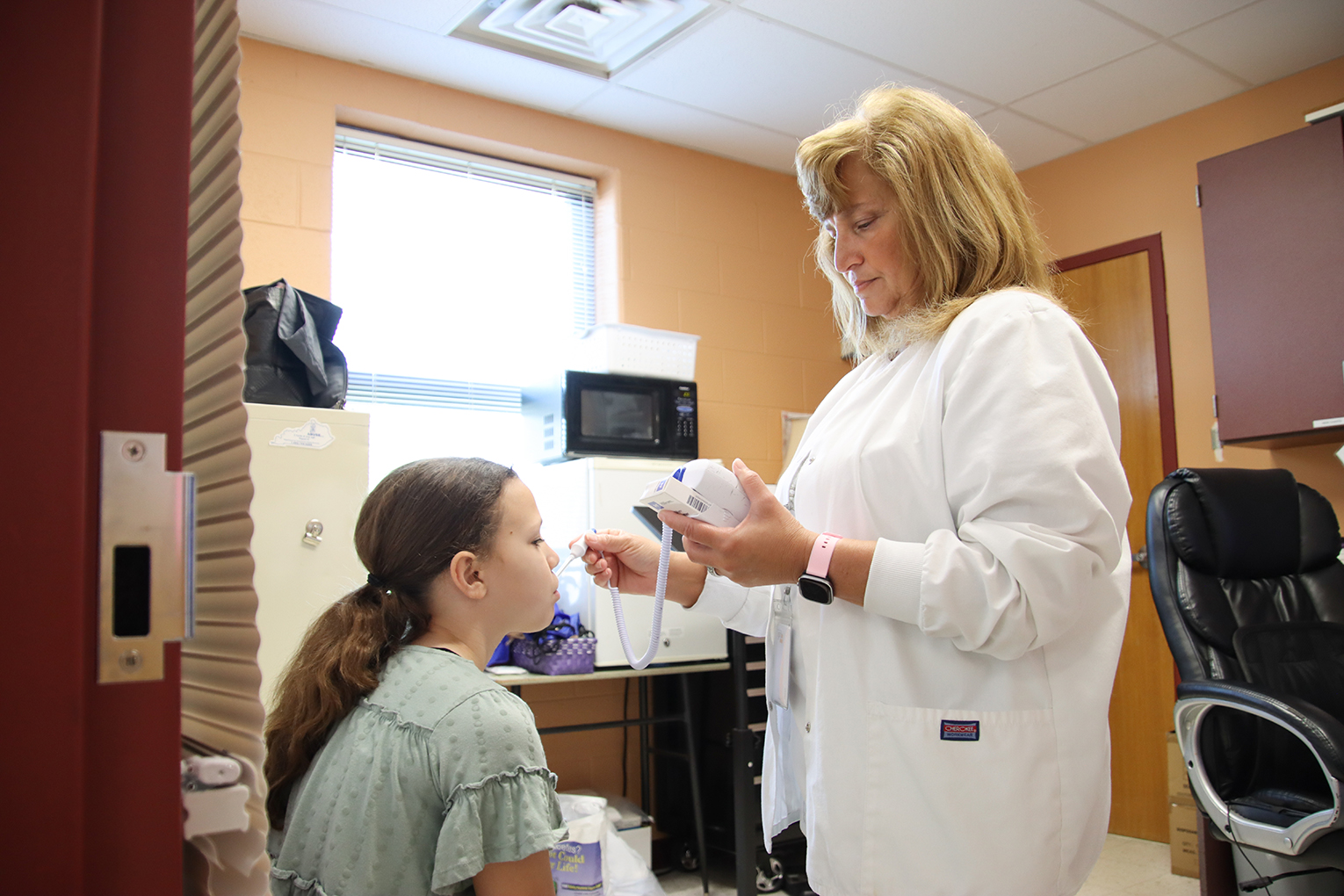
Atkinson Academy (Jefferson County) teachers Margot Smith and Leslie Montgomery wrote Word Nerds Teaching All Students to Learn and Love Vocabulary. They stressed creating a classroom atmosphere where students feel safe to learn about language and take risks.
Photo by Amy Wallot, Feb. 5, 2013
By Matthew Tungate
When teachers Leslie Montgomery and Margot Holmes Smith started at Atkinson Academy (Jefferson County) in 2007, they followed the prescribed literacy program. Smith, who was a 3rd-grade teacher at the time, said the pattern for teaching vocabulary was simple – introduce the words and give the definitions; write a sentence with the words; read a story with some of the words; and give an assessment – but ineffective.
“The level of rigor just wasn’t there. The kids weren’t retaining the words because they had no attachment to the words,” she said.
Fortunately, following that school year the two teachers participated in an Every 1 Reads conference. They were impressed by a video of a teacher who taught vocabulary words by introducing synonyms and acronyms.
“That’s how this all came about, because we were like, ‘Our kids would benefit so much from that.’ Because we saw them teaching vocabulary at a much deeper level,” Smith said.
So the two teachers began to work on a framework that ultimately would lead them to implement creative vocabulary lessons that improve students’ word knowledge and confidence, build a classroom community and increase achievement. Montgomery and Smith weave vocabulary into each school day, teaching to multiple learning styles through music, art, literature, movement, games, drama, writing, test-taking skills and technology.
Montgomery, a 5th-grade teacher, and Smith, who is now a 5th-grade intervention teacher, have worked since then with their former graduate school professor Brenda Overturf to develop a five-part method – introducing new words in context, adding related synonyms and antonyms, engaging students in several days of active learning, celebrating new words and assessing vocabulary development – that they say is working wonders. The trio has even written a book about their methods.
“It wasn’t until that summer professional development when we were like, ‘We really have to change our instruction to be more meaningful and more purposeful and more intentional, especially when it comes to vocabulary,” Smith said.
Montgomery said students didn’t have any confidence to figure out words they didn’t know. Even though they might know the content, students would “shut down” when faced with unfamiliar words.
“We knew that whatever we did, a huge role had to be that we were teaching them confidence and strategies to attack anything that’s unfamiliar instead of shutting down and being afraid of it,” she said. “Not only did we want to have a plan that obviously would increase their word bank, but also that would provide them a word confidence in themselves.”
Following their first year, then 3rd-grade teacher Montgomery and Smith planned together how they would implement their changes within each two-week unit.
“We talked about it daily and adjusted things as we needed, we added things, we changed things, we took things out that we didn’t think were working, but it was very, very intentional,” she said.
The pair knew the only way for the student to retain information was to give them attachment to it, so they had to give them an experience, Montgomery said. For instance, a child who goes to the ocean every summer knows what a tide is, she said.
“But for a lot of our kids that have not left their neighborhood, we needed to give them an experience,” Montgomery said. “So we can’t just tell them the word and what the definition is – they need to read stories about the tide, they need to sing a song about the tide, they need to move like the tide. Now they have ownership of it.”
Smith said the teachers originally taught five vocabulary words per week, alternating between science and social studies. What they realized was that teaching more words isn’t as effective as focusing on five or six rich words. Since words are so connected you can teach a variety by adding in the synonyms and antonyms, she said.
Montgomery said students learn two synonyms and two antonyms with each of the five or six vocabulary words, so they really learn upwards of 30 words.
“Even though the vocabulary instruction did take up a little more of our reading block, we found that it wasn’t a negative thing because it truly was improving their competency, it was improving their fluency, it was improving their phonics and comprehension, and also their motivation and word confidence improved greatly,” she said.
Smith said teaching antonyms and synonyms also allowed them to teach students how to break down and connect words, allowing them to recognize similarities with other words and to increase their word knowledge even further. Now, instead of shutting down when they saw unfamiliar words, they learned how to use context clues to figure out the meanings and how to decode unfamiliar words, she said.
In the years that followed, the teachers continued to work with Overturf to refine their activities. Montgomery said Overturf would ask questions like “Why are you doing this? What is the benefit?” to make them look deeply into their instruction.
Smith added that most of the research backing up their methods came from Overturf.
“We weren’t doing this just because it was a fun activity,” Smith said. “We’re doing this because it has meaning behind it.”
Now they have students playing Pictionary and Deal or No Deal with vocabulary words – and questions they designed themselves. Students celebrate words with parties and dig through thesauruses looking for what Montgomery called “juicy words” like peripatetic, a synonym for nomadic.
“As an adult, that’s very exciting for me because I didn’t know what that was,” she said.
Smith told a story about a group of students who were comparing Paul Revere’s Ride to a fictional play about a girl who went on a similar nighttime ride.
During the discussion, a “hard-to-motivate” student used a vocabulary word from two weeks prior, Smith said.
“It just rolled off his tongue and out of his mouth like a word he had known it forever,” Smith said. “It was nice to see that deeper level of comprehension going on.”
To get similar results, Smith encouraged teachers to find another teacher with whom to collaborate, establish procedures and routines in the classroom, and tell students you believe in them.
Montgomery said their method of teaching vocabulary does take some time up front, but it applies directly to the Kentucky Core Academic Standards for English/language arts and provides a big payoff. She also believes that the vocabulary plan is great for building classroom community, which is necessary when encouraging students to take risks.
“These are things that not only have happened in our classrooms but are happening today,” she said. “We’ve seen it work over and over again.”
MORE INFO…
Leslie Montgomery, leslie.montgomery@jefferson.kyschools.us, (502) 485-8203
Margot Holmes Smith, margot.holmes@jefferson.kyschools.us, (502) 485-8203











Leave A Comment